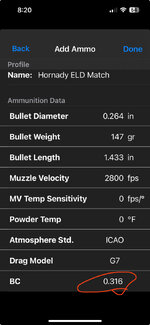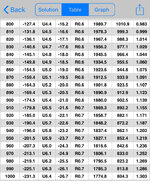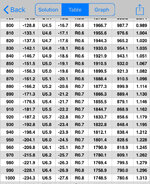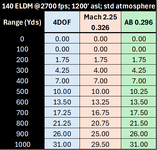- Joined
- Jul 29, 2020
- Messages
- 1,195
This kind of stuff is precisely what I mean in my earlier comments about box values being unreliable.The Hornady 2.25 Mach Value for a 147 ELDM is .351 and i have ran a .320 out of my last 2 NRL Hunter Rifles, a factory Bergara was .330, and my PRS rifle was a .330. (Those numbers won 3 matches and have 2 more top 3s) That matches up to the provided Mach 2.0 BC but the .351 is whats on the box. I ran the velocity off my Chrono and then trued the BC from there. As far as i know thats how everyone winning in PRS and NRL Hunter does it. I have found that trueing the BC is a more accurate way for all the rifles i have been around.
I don't look at box values for anything. The Applied Ballistics library is put together with live fire doppler testing of all common bullets.
Pulling up the 147 ELDM in AB gives a 0.316 G7 BC. Hornady advertises 0.351
The 140 ELDM pulls up with 0.296 in AB. Hornady advertises 0.326
Hornady is a significant offender of inflated BC's if you are a believer of AB data as I am.
I use their library BC's (which almost always have a lower value than box), input speeds from the chrono, and dope lines up excellent






